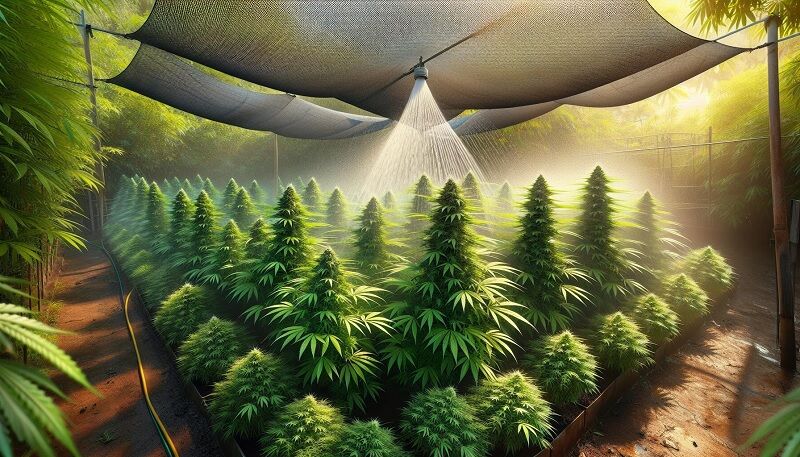How to protect growing cannabis from heat stress

Growing cannabis in the sun-soaked paradise of Thailand is an absolute thrill ride, packed with excitement at every turn! But brace yourself, because it’s also filled with some wild challenges! Battling the blazing sun and sizzling heat is like facing a fiery dragon. Those glorious rays are incredible for nurturing lush, vibrant cannabis plants, but sometimes it feels like we’re basking in a little too much sunshine – kind of like indulging in one too many scoops of your favorite ice cream. Without careful attention, that relentless sun can leave our precious green pals stressed and underperforming.
But guess what? There’s no need to break a sweat over it! Figuring out how to shield your beloved cannabis from that bold Thai sun isn’t just possible; it’s an exhilarating quest essential for any grower dreaming of epic harvests. Whether you’re scouting the ultimate location or devising ingenious strategies to filter those intense rays, there’s a whole arsenal of cool tricks up our sleeves to keep your plants thriving and joyful.
Understanding heat stress in cannabis

In the vibrant territories of Thailand, the cultivation of cannabis presents a unique array of challenges. Chief among these is heat stress, a significant obstacle for growers. This section aims to elucidate the causes and indicators of heat stress in cannabis plants, thereby equipping cultivators with essential knowledge to overcome these tropical difficulties.
Causes of heat stress in cannabis plants
Cannabis is notably resilient; however, it possesses its limitations. Heat stress manifests when plants are subjected to temperatures beyond their optimal range. In Thailand’s tropical climate, where temperatures frequently ascend, several factors contribute to this condition:
Excessive Temperatures: The ideal growth temperature for cannabis ranges between 20°C and 30°C. Thailand’s elevated temperatures, especially during summer months, can surpass these boundaries.
Low Humidity: Elevated heat coupled with fluctuating humidity levels in Thailand can intensify heat stress. Cannabis plants depend on transpiration for cooling; low humidity levels can impede this process.
Direct Sunlight: While sunlight is essential for cannabis growth, excessive direct exposure during peak temperature periods can increase leaf temperatures to unsafe levels.
Comprehending these causes is vital for implementing preventative strategies to safeguard your cannabis plants.
Importance of protecting cannabis from heat stress
Heat stress triggers a range of problems in cannabis plants. Initially, you might notice the leaves curling upwards, a plant’s cry for help against excessive heat. As the stress prolongs, the effects become more severe, leading to stunted growth and compromised yields. In Thailand, the high temperatures mean these risks are ever-present, making heat management strategies essential for any grower.
One might wonder, why go through all the trouble? Beyond the immediate threat to your crop, heat stress can have lasting impacts on the potency and flavour profile of your cannabis. High temperatures can degrade essential oils and terpenes, the compounds responsible for a strain’s unique aroma and effects. Ensuring your cannabis thrives, despite Thailand’s intense heat, preserves these qualities, maintaining the plant’s medicinal and recreational value.
Furthermore, your efforts to mitigate heat stress have a direct correlation with your harvest’s success. Healthy, unstressed plants are more resilient and productive, capable of producing high-quality buds in abundance. In Thailand’s competitive cannabis market, standing out means delivering consistency and excellence, achievable only by protecting your plants from the extremes of the climate.
How to identify heat stress?
First, leaves curling upward is a clear indicator. This isn’t about the gentle curve of a healthy leaf, but a pronounced curl that suggests the plant is trying to reduce its surface area exposed to heat. If your cannabis plants’ leaves resemble this, it’s a signal they’re under heat stress.
Another symptom is a dry and withered appearance, akin to plants that haven’t been watered enough. These plants might droop or wilt, showcasing their struggle against the heat. This symptom is particularly deceptive because it mimics under-watering, yet the issue lies with the temperature, not the irrigation.
Look out for irregular or large brown spots or yellow blotches on the leaves, especially on the edges and tops of the canopy. Unlike nutrient deficiencies, which often affect the lower leaves first, heat stress targets the parts of the plant closest to the light source.
Finally, foxtailing in flower is a peculiar symptom of heat stress during the flowering stage. It occurs when new buds grow out of the tops of already developed ones, leading to an elongated structure. This differs from the typical rounded shape of healthy buds and is a sign your plants might be experiencing extreme conditions.
In indoor setups, plants too close to lights might show signs of burn, particularly on upper portions. During the flowering stage, excessive heat might promote the appearance of more white pistils in the final weeks, a deviation from the expected coppery color pre-harvest.
By staying observant and catching these signs early, you can protect your cannabis from the harsh effects of Thailand’s heat. Adjustments to growing conditions can often reverse heat stress, provided you act swiftly.
Tips for protecting cannabis from heat stress in Thailand

Providing adequate shade
In Thailand’s intense heat, providing shade is essential for cannabis cultivation. Use shade cloths or screens to diffuse direct sunlight, particularly during peak hours. This helps in maintaining an optimal temperature range, preventing the adverse effects of heat stress. Positioning these shades effectively requires understanding the sun’s trajectory over your grow area. Remember, the goal is to shield your plants without depriving them of their crucial light source.
Proper watering techniques
Ensuring the optimal hydration of our cannabis plants is of paramount importance, particularly during periods of increased temperatures. A useful strategy involves watering your plants either in the early morning or late evening when temperatures are more moderate. This practice ensures that water reaches the roots effectively, rather than evaporating prematurely. Additionally, incorporating mulch around your plants can significantly retain soil moisture without leading to oversaturation, thereby preventing root rot. However, it is crucial to moderate watering practices to avoid detrimental effects on plant health.
Discussing optimal lighting conditions
It is widely acknowledged that cannabis plants have a preference for ample sunlight; however, excessive exposure, especially in warmer climates such as Thailand, can induce stress in these plants. To mitigate this, consider providing partial shade or repositioning potted plants periodically to afford them some respite from direct sunlight. Reflective surfaces can also be employed to deflect excess light away from the plants effectively. For those cultivating indoors, adjusting artificial lighting systems to replicate natural diurnal patterns can prevent overheating while ensuring sufficient light for healthy growth.
Monitoring plant health closely and being prepared to adapt your care approach are essential tactics for managing heat stress effectively. By maintaining these techniques in your cultivation practices, you will enhance your chances of achieving high-quality cannabis plants.
Through increased watering, strategic shading, adjusted feeding, cautious pruning, and the careful monitoring of environmental conditions, you can create a thriving environment for your cannabis plants. Stay attentive to the signs of heat stress and act swiftly to mitigate its effects. Your efforts will be rewarded with healthy, robust plants ready to flourish in even the hottest conditions.
Considering the above-shared details, You can also explore the environmental effects cannabis shows, As you navigate through the complexities of these changes, understanding the specifics of how cannabis will be grown and the legalities involved is crucial. This section explores the agricultural practices and legal frameworks shaping the future of cannabis in Thailand.
Latest Thailand News
Follow The Thaiger on Google News:


























